The next cave my friend Sneža and I visited in Ajanta was Cave no. 10. This cave is considered one of the oldest in Ajanta and it is dated back to the period of the 2nd century BCE. By its architectural concept it is a chaitya-griha, i.e., in the back, opposite the entrance, it has a votive stupa and a semi-circular apse, and it also has vaulted ceiling. Around the central nave, there is a circumambulatory path which is separated from the central section by a large number of pillars.
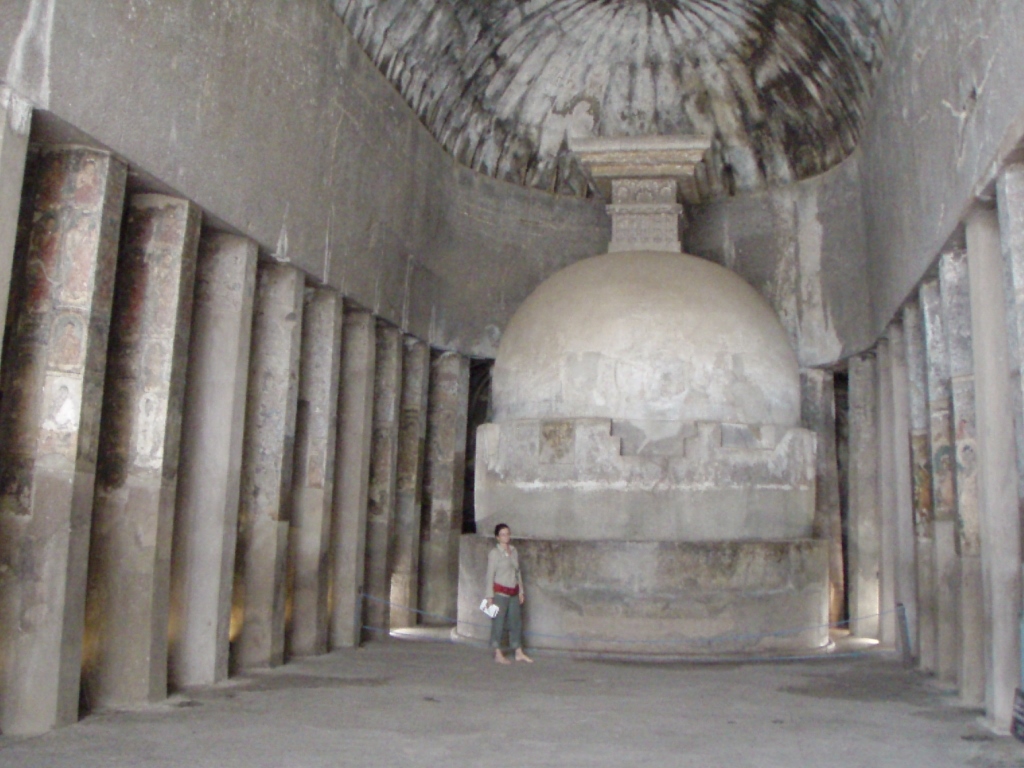 Sneža in the interior of Cave no. 10
Sneža in the interior of Cave no. 10
This cave has very beautiful paintings on the pillars that show a prince worshipping the Bodhi Tree.
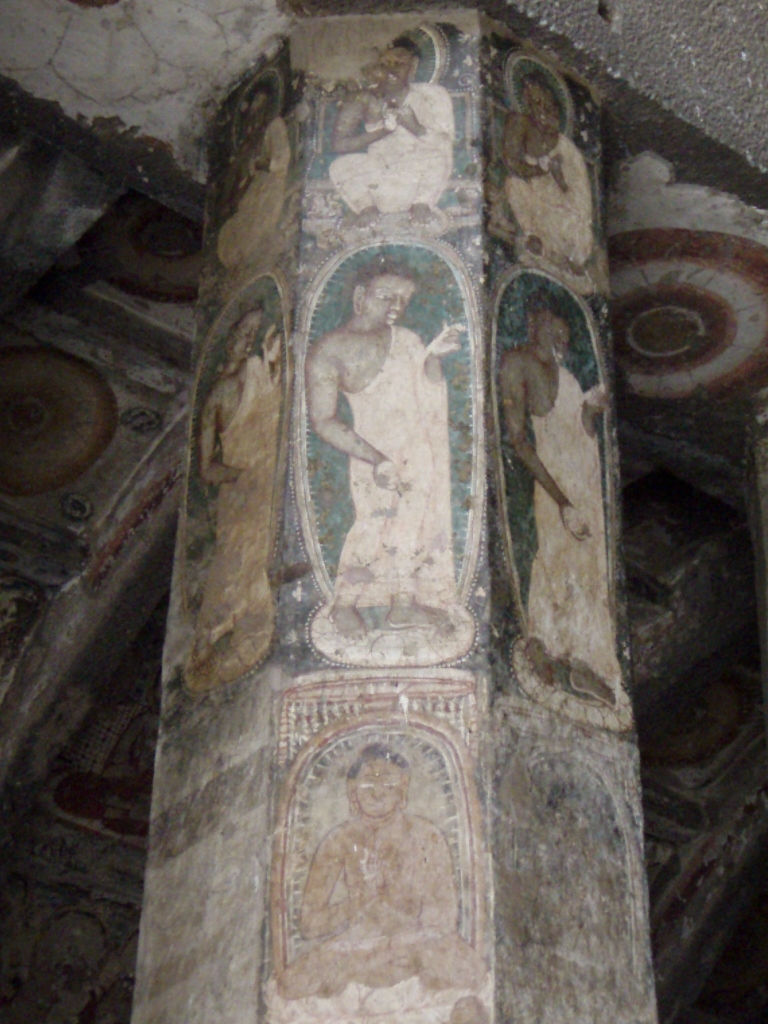 Detail from the pillar in Cave no. 10
Detail from the pillar in Cave no. 10
When we got out from this cave, I looked back and it was nice to see the part we have already passed. Of course, when visiting this site, it is important to bear in mind that there is a lot of walking to do. On the day we were there, it was, needless to say, hot with no wind whatsoever, so the climbing up and down the steps was not always very pleasant.
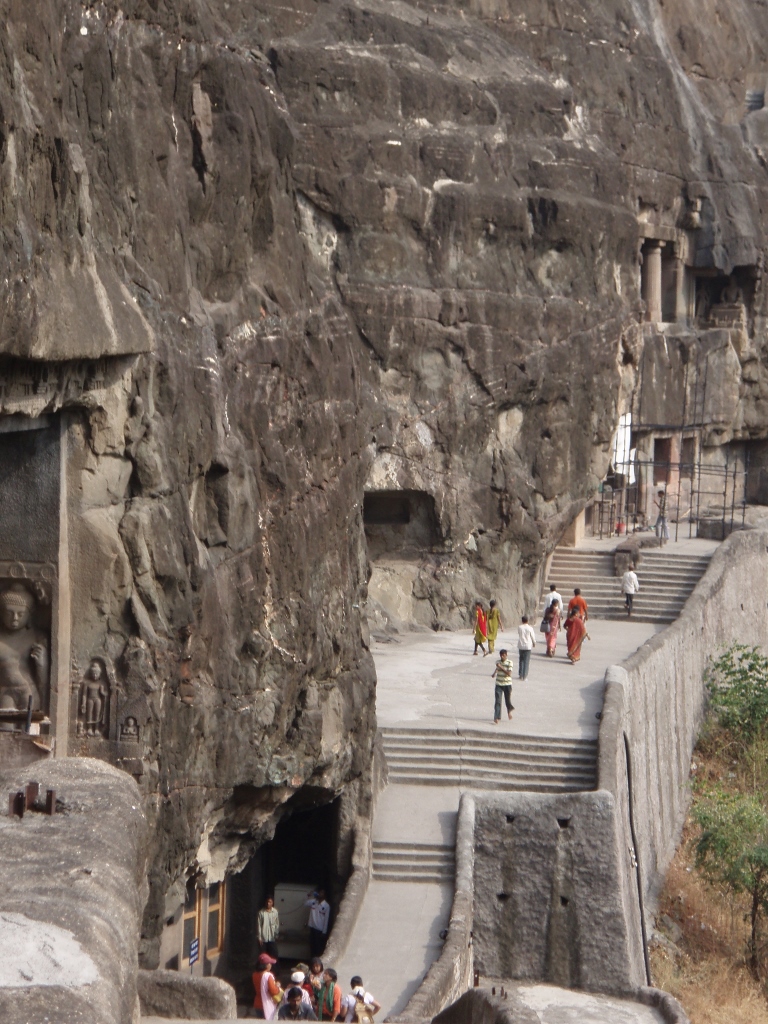 Path by which Ajanta Caves are visited; completely to the left is a part of Cave no. 9 and on the right-hand side is Cave no. 6
Path by which Ajanta Caves are visited; completely to the left is a part of Cave no. 9 and on the right-hand side is Cave no. 6
Then there were several caves that we visited a bit more superficially, since we were actually keen on getting to Cave no. 16. Among other things, this one is also interesting because of its entrance that is decorated with two elephants. The cave itself has only one floor, but in order to get to it, one needs to climb the stairs after passing between the elephants.
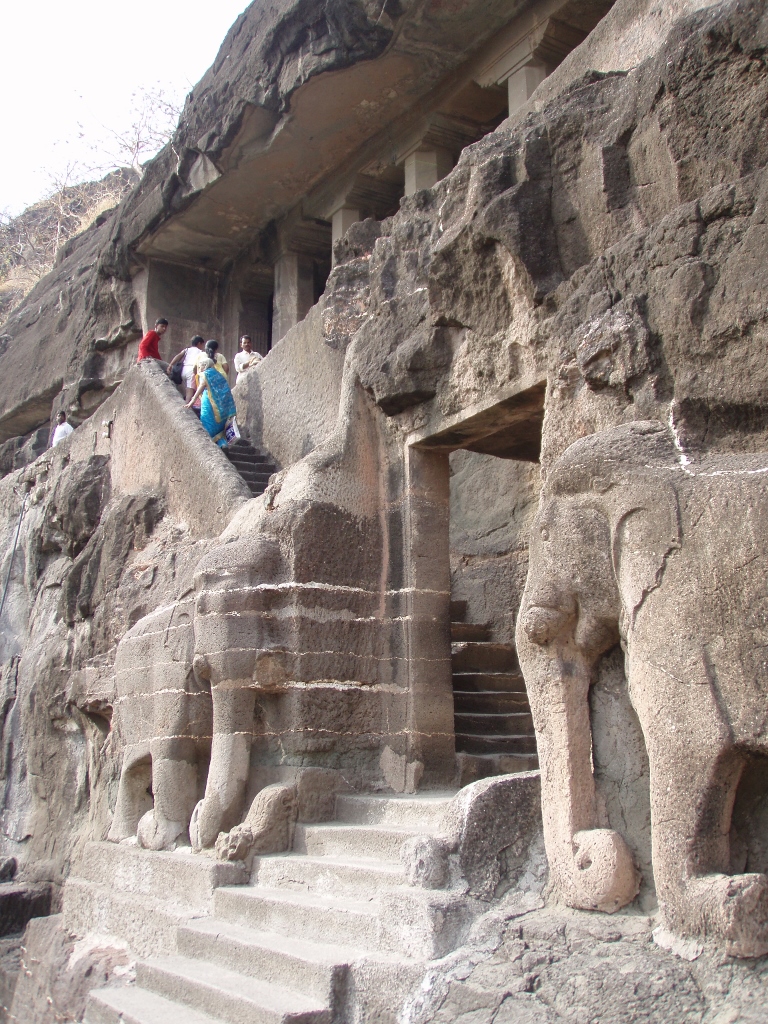 Entrance into Cave no. 16
Entrance into Cave no. 16
Although in Cave no. 16 there are some extraordinary wall paintings, it is actually the next one, Cave no. 17, that contains the biggest number of murals. To start with, already on the veranda it was possible to see some very nice wall paintings.
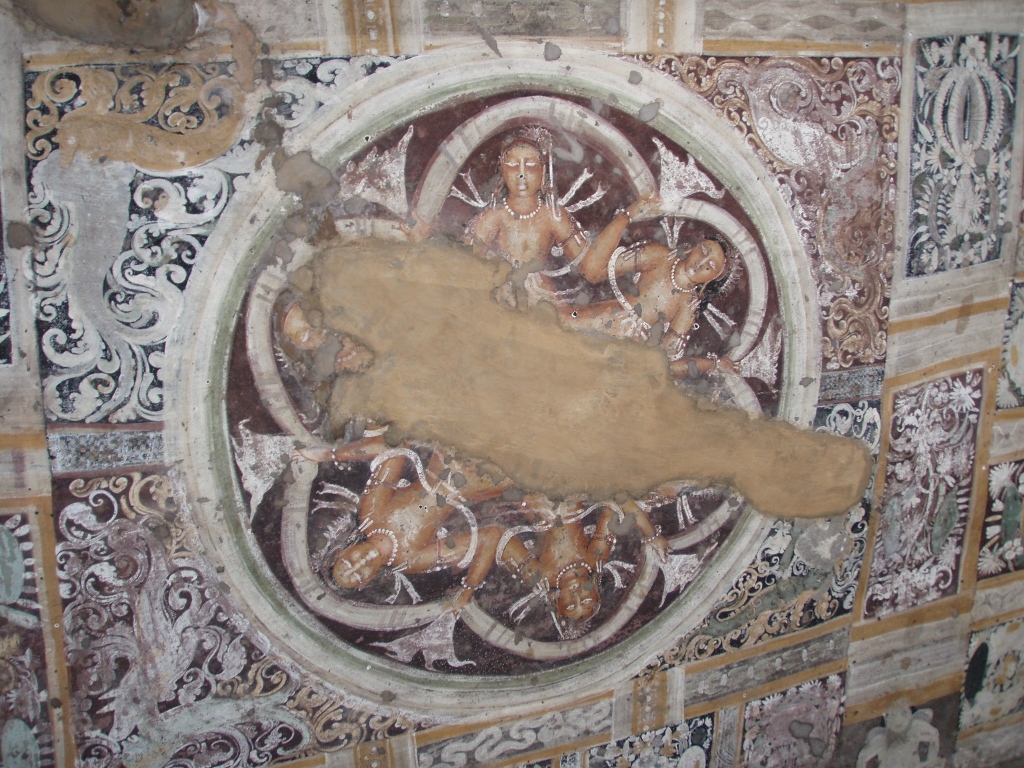 Detail from the ceiling on the veranda of Cave no. 17
Detail from the ceiling on the veranda of Cave no. 17
There is also a sequence of eight sitting Buddhas that adorn the lintel under which there are depicted amorous couples.
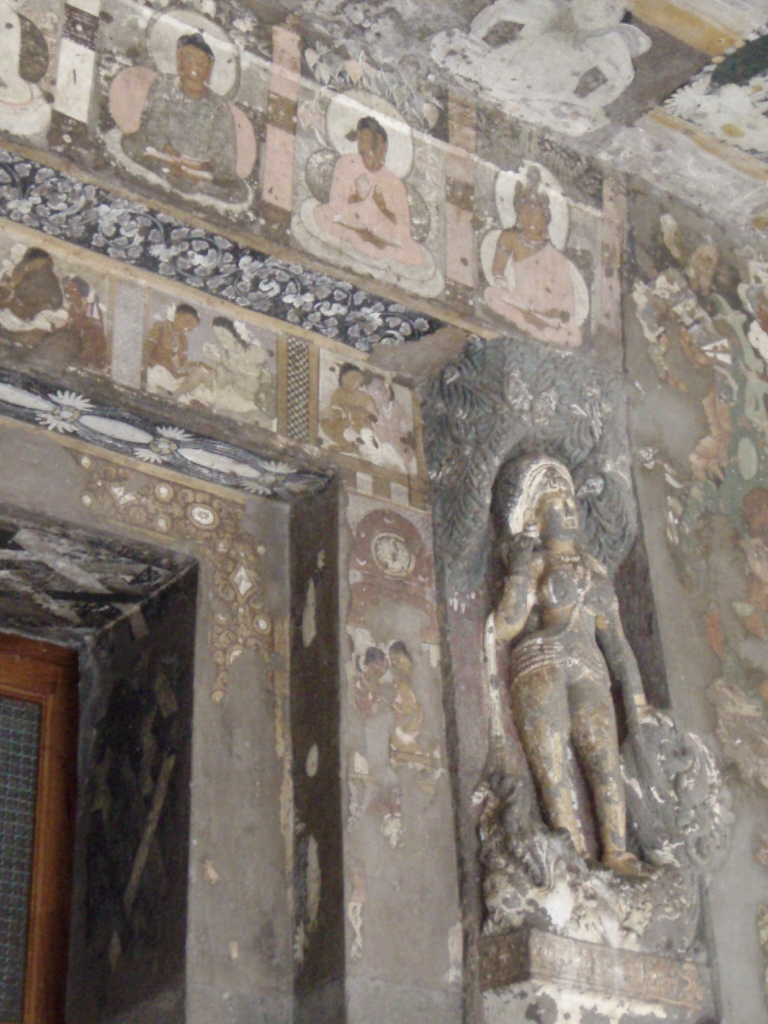 Entrance into Cave no. 17: a few of the painted sitting Buddhas and underneath them there are also the amorous couples
Entrance into Cave no. 17: a few of the painted sitting Buddhas and underneath them there are also the amorous couples
Within the cave there are painted compositions that show different stories related to Buddhism. One of these is composition Simhala Avadana that shows the arrival of Prince Simhala to Sri Lanka.
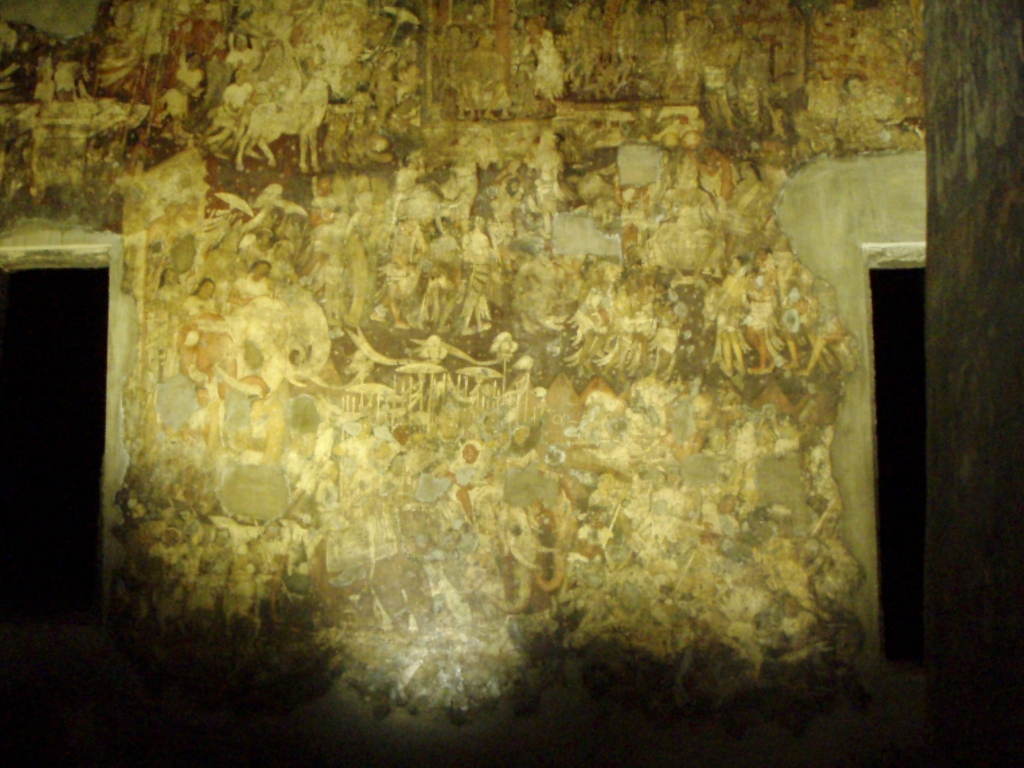 Simhala Avadana composition
Simhala Avadana composition
There is also a very nice composition called King's White Elephant or Shaddanta Jataka, which depicts the story about a bodhisattva in the shape of an elephant who gave its tusks.
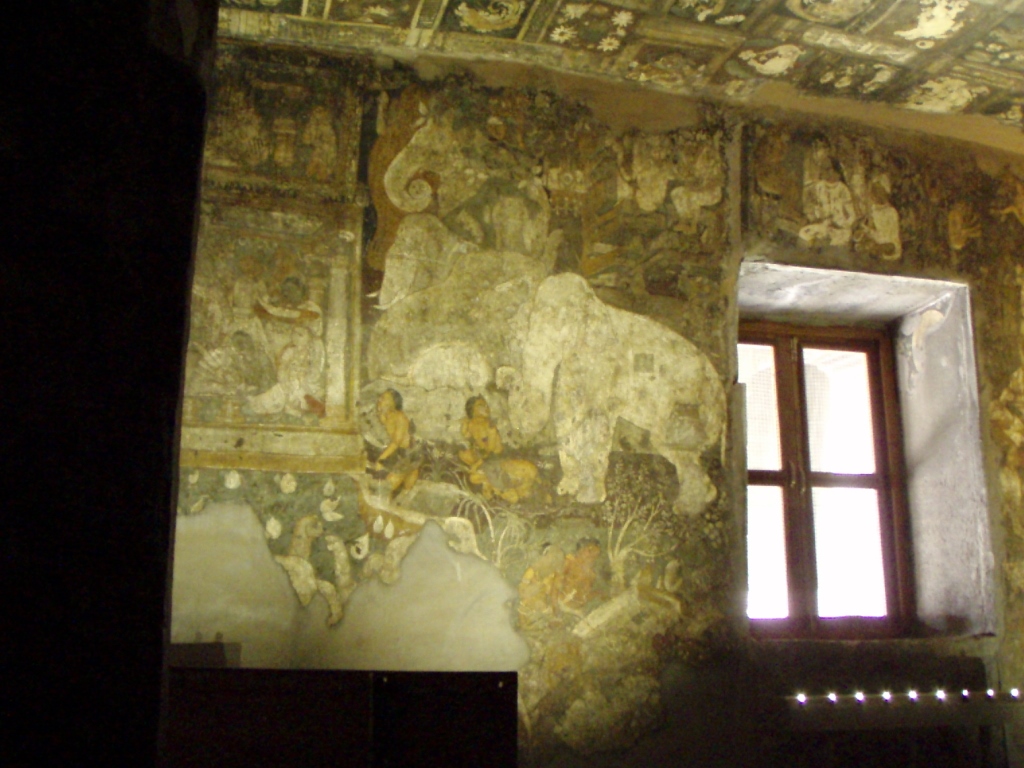 Shaddanta Jataka composition
Shaddanta Jataka composition
Then we reached Cave no. 19 that is yet another one of those that have a very complex facade. To start with, you first enter a square courtyard and from there you see the facade. Bear in mind that all that can be seen was actually carved directly into the rock. All the time in Ajanta I could not stop admiring such skilfulness, vision and the capability of implementation.
 Entrance into Cave no. 19
Entrance into Cave no. 19
Cave no. 19, which is of the chaitya-griha type, was made in the 5th century CE and it makes a link between the Buddhist periods of Hinayana and Mahayana (see: https://svudapodji.com/en/india-19/) by having a carved Buddha already made on the stupa itself.
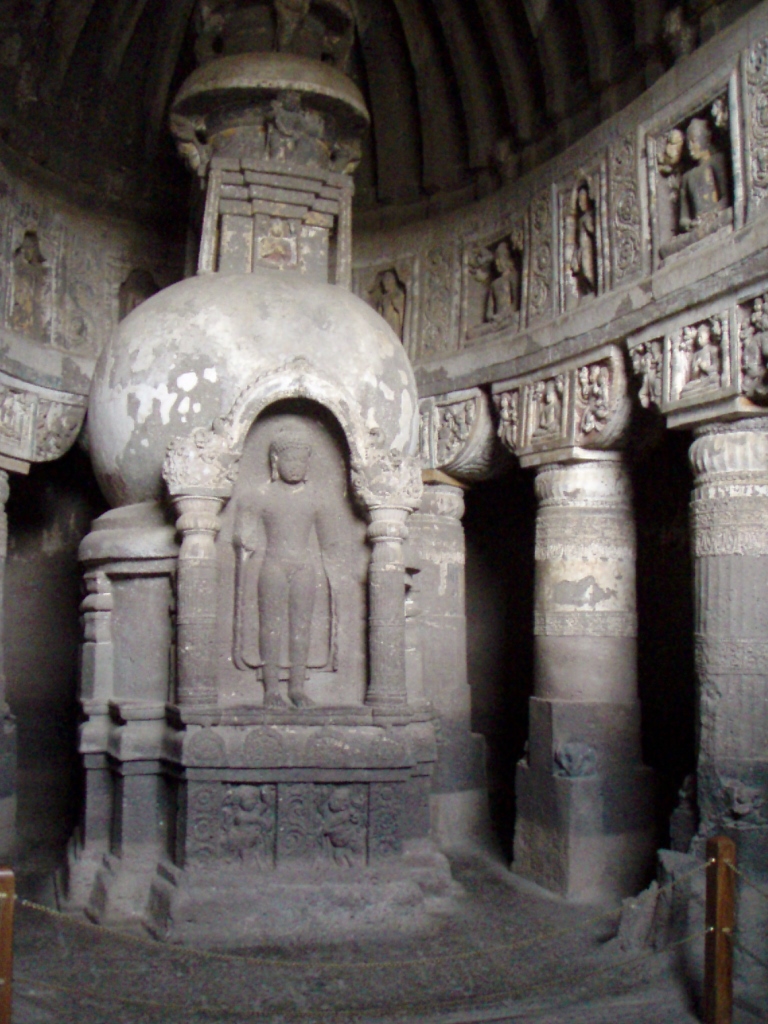 Stupa and Buddha in Cave no. 19
Stupa and Buddha in Cave no. 19
Of course, every time I would come out of a cave, I would look back and look around. And every time it seemed impressive.
 Ajanta Caves and the canyon of the Waghora river
Ajanta Caves and the canyon of the Waghora river
Then came the visits to the caves from number 20 to number 25. I would single out Cave no. 21 in the central sanctum of which Buddha is sitting in the preaching posture, as well as Cave no. 24 that is not finished, but for this reason represents an excellent example showing how the making of these temples and shrines was done.
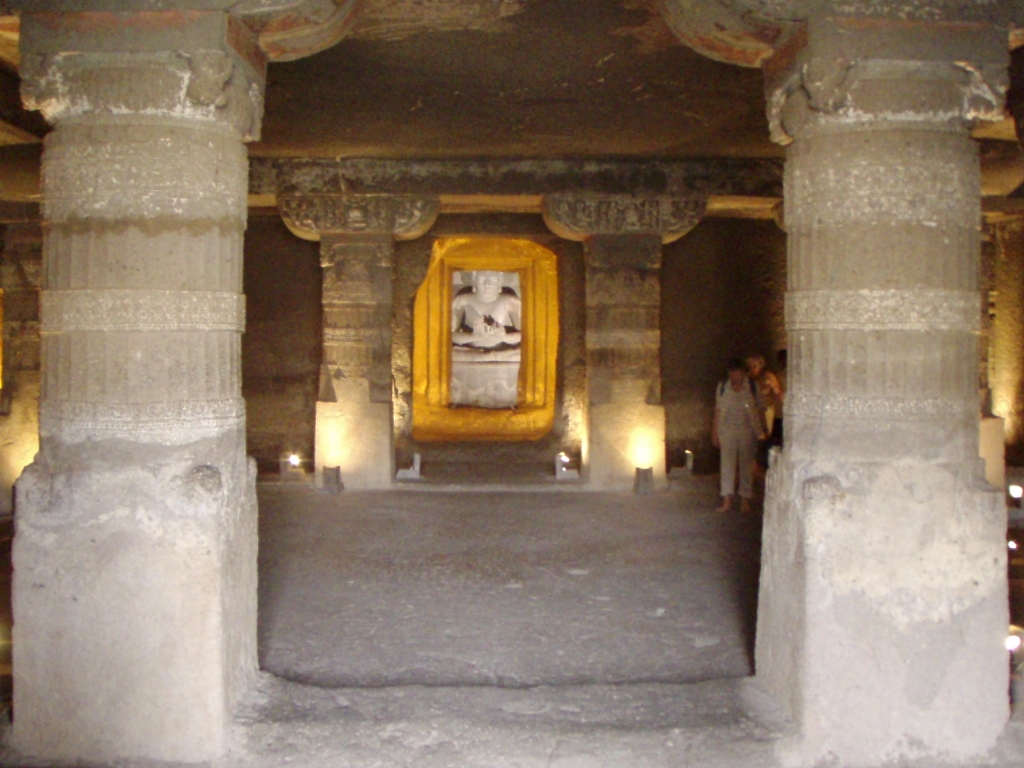 Cave no. 21
Cave no. 21
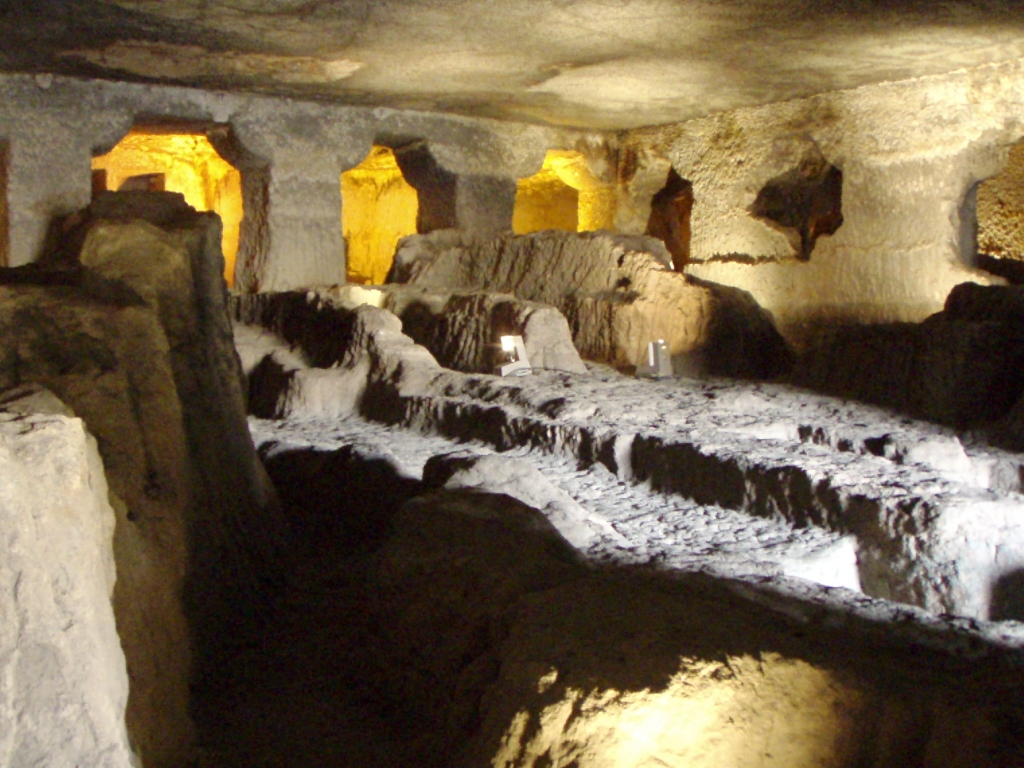 Cave no. 24
Cave no. 24
And then we came to Cave no. 26 with intricately decorated facade and a semi-circular window opening.
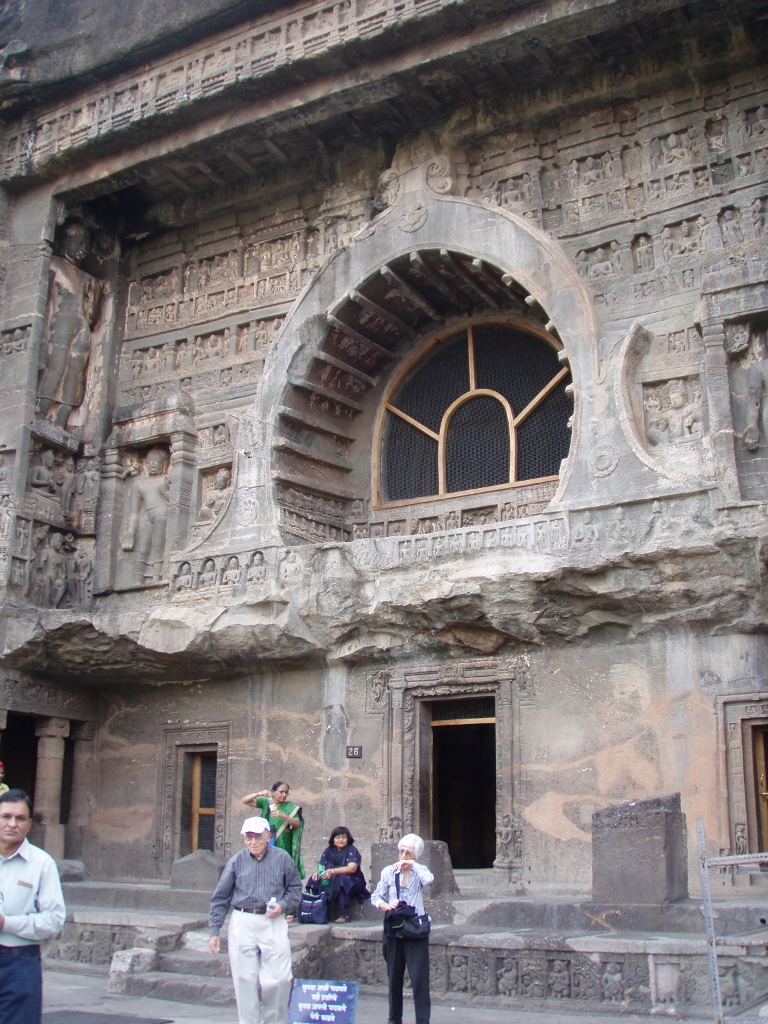 Entrance into Cave no. 26
Entrance into Cave no. 26
As it can be seen in the photo, the central window is placed rather high, but it does not hide any upper storey, rather, this is a typical chaitya-griha with a stupa, semi-circular apse, as well as a high vaulted ceiling. Like in the case of Cave no. 19, here, too, there is an influence of the Mahayana period, which can, among other things, be seen by the depiction of Buddha on the stupa itself.
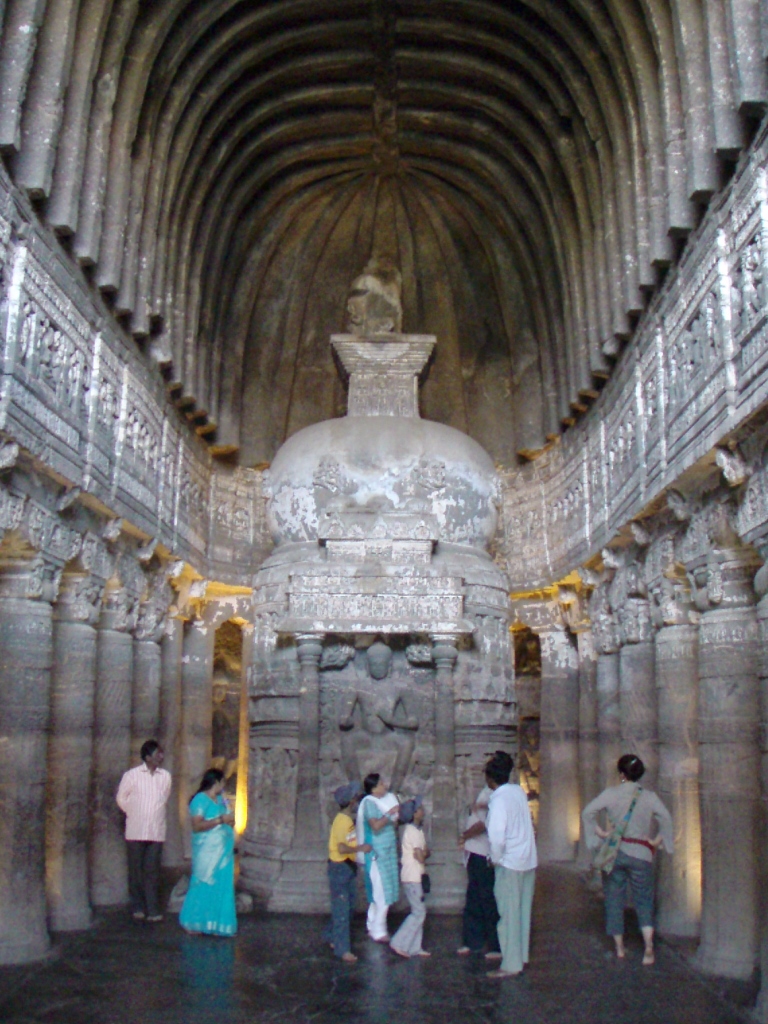 Stupa in Cave no. 26
Stupa in Cave no. 26
This cave also dates back to the 5th century CE and it contains an inscription which says that it was made as a gift of a monk and his friend, a minister. The inscription also says that the cave was made to last as long as the Sun and the Moon. It is presumed that because of this intention, there is more sculpture as the artistic expression element here, since it would be logical to think that sculpture in stone would last longer than any wall painting.
Thus, the wall in the circumambulatory passage is very richly decorated.
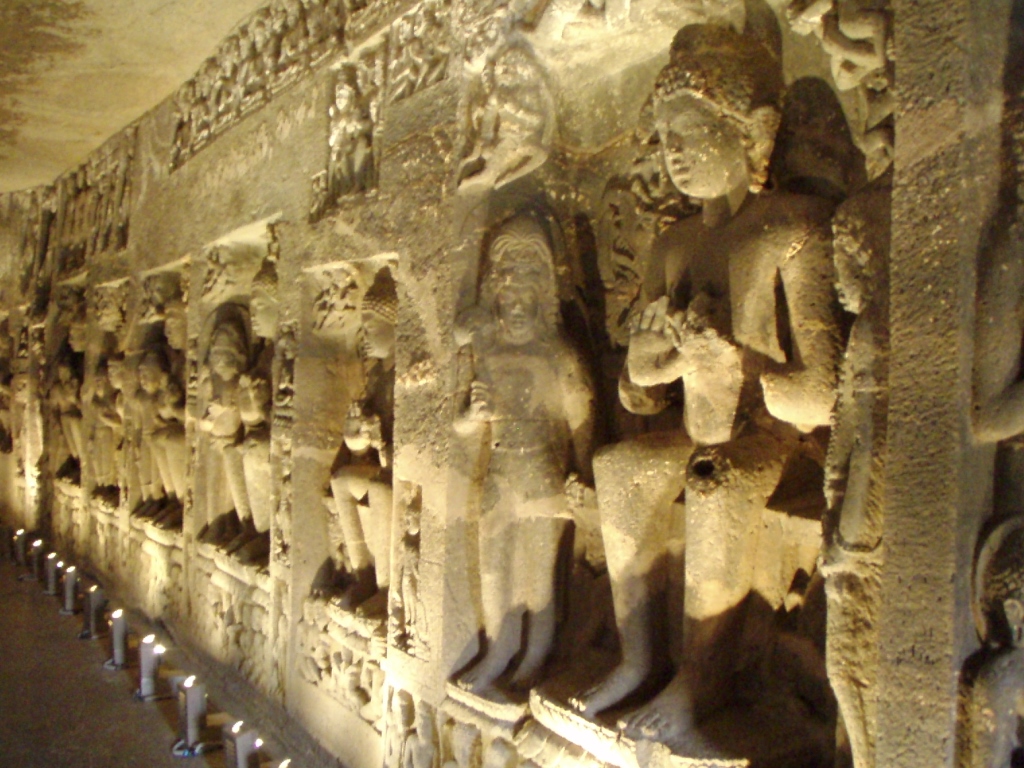 Wall to the right from the entrance into Cave no. 26
Wall to the right from the entrance into Cave no. 26
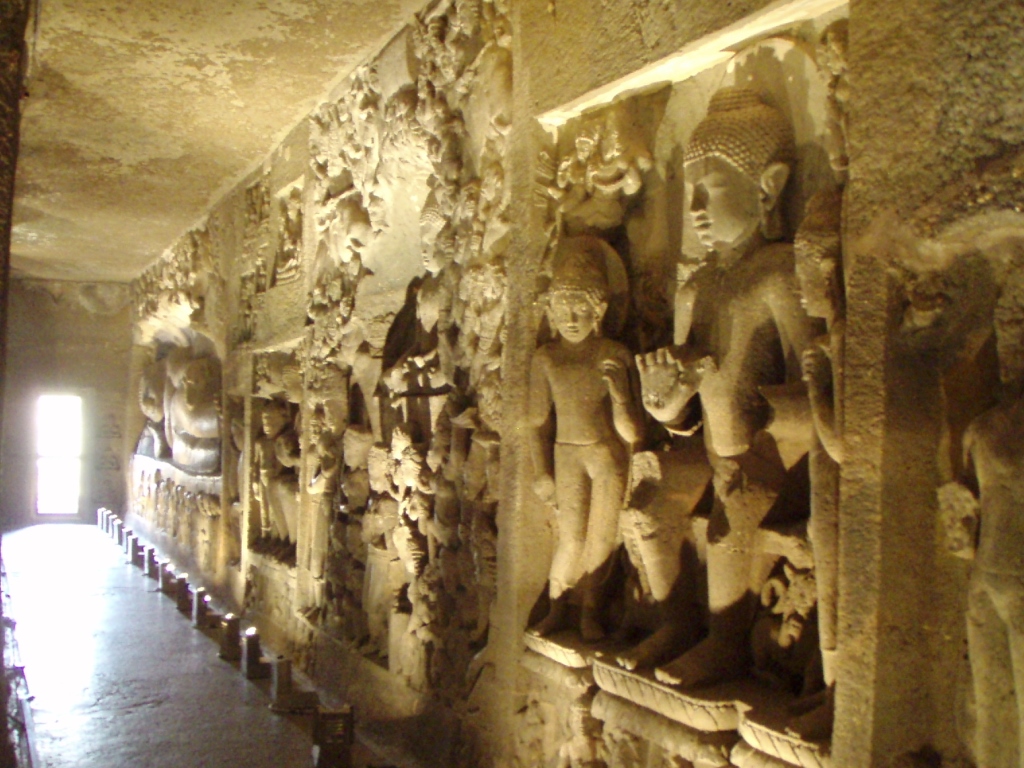 Wall to the left of the entrance into Cave no. 26
Wall to the left of the entrance into Cave no. 26
Maybe even the best-known sculpture in all of Ajanta is precisely one that can be seen in the photo above and that is a depiction of Parinirvana of the Buddha or the reclining Buddha. This is a 7-metre long bas-relief that shows Buddha at the moment of passing. Generally speaking, Parinirvana is the term used for the death of somebody who has already attained enlightenment thus entering the state of nirvana, which then means that only the physical body is dying, while the being is getting free and is leaving the Wheel of Karma.
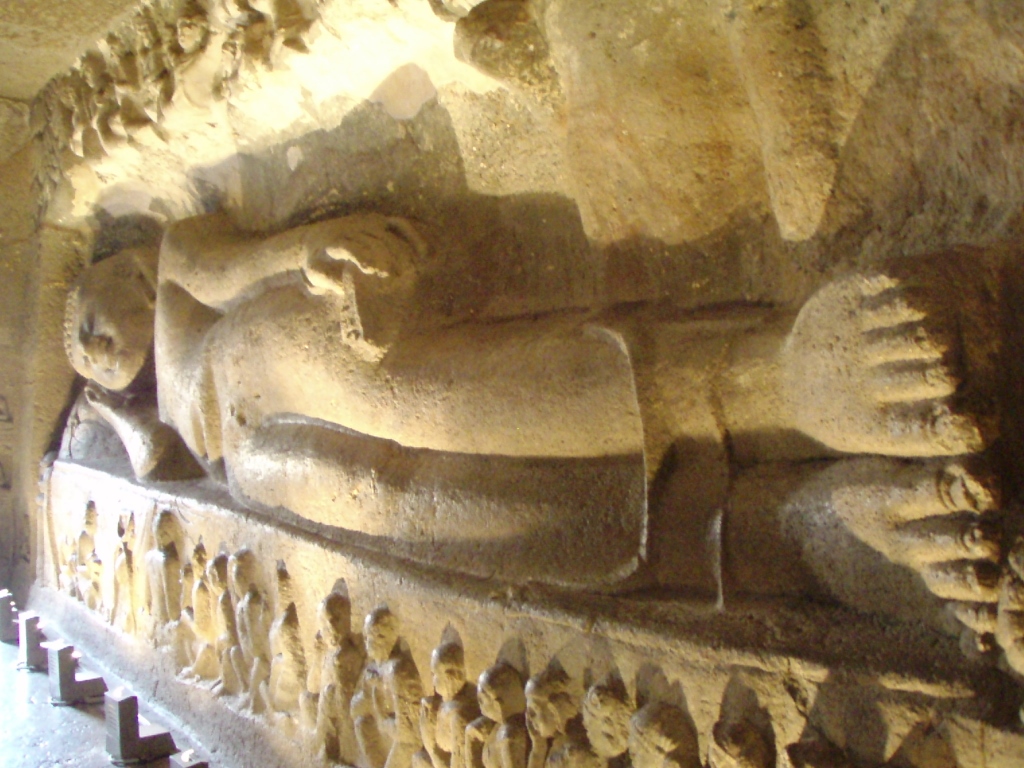 Parinirvana of the Buddha
Parinirvana of the Buddha
Buddha’s eyes are closed as if he were asleep and while his disciples (underneath Buddha) mourn his departure, the celestial beings that can be seen above Buddha are celebrating this moment.
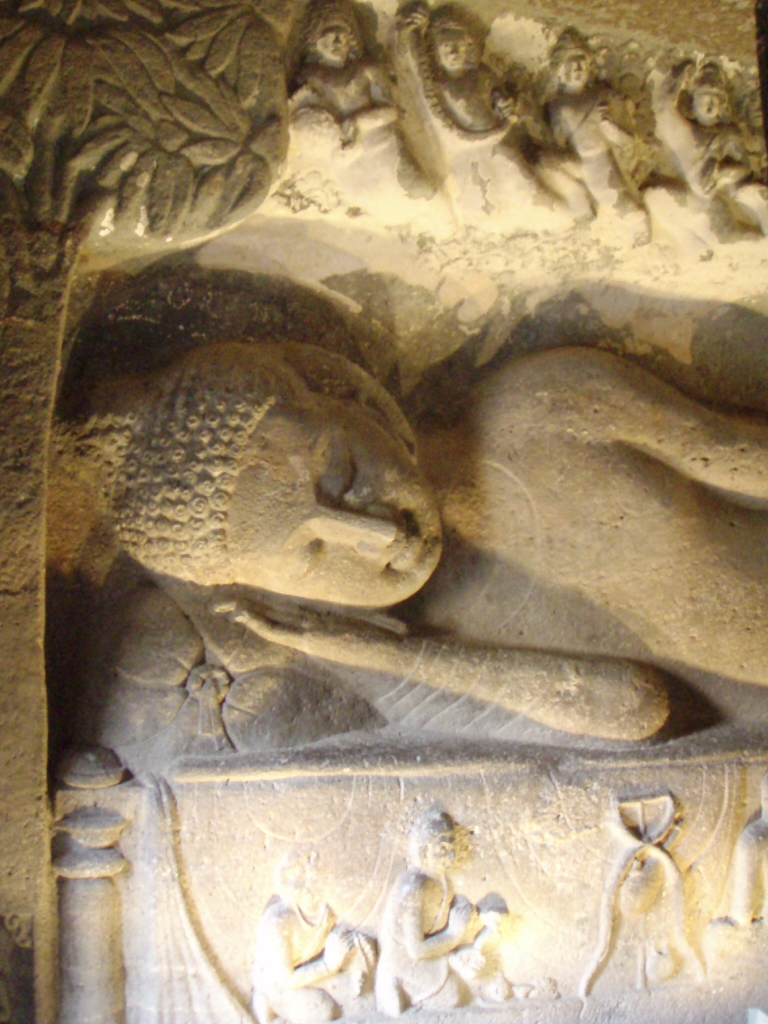 Parinirvana of the Buddha
Parinirvana of the Buddha
By the way, irrespective of the fact that these temples or shrines are not active, in front of each one there was a board clearly stating that the visitors must take their shoes off.
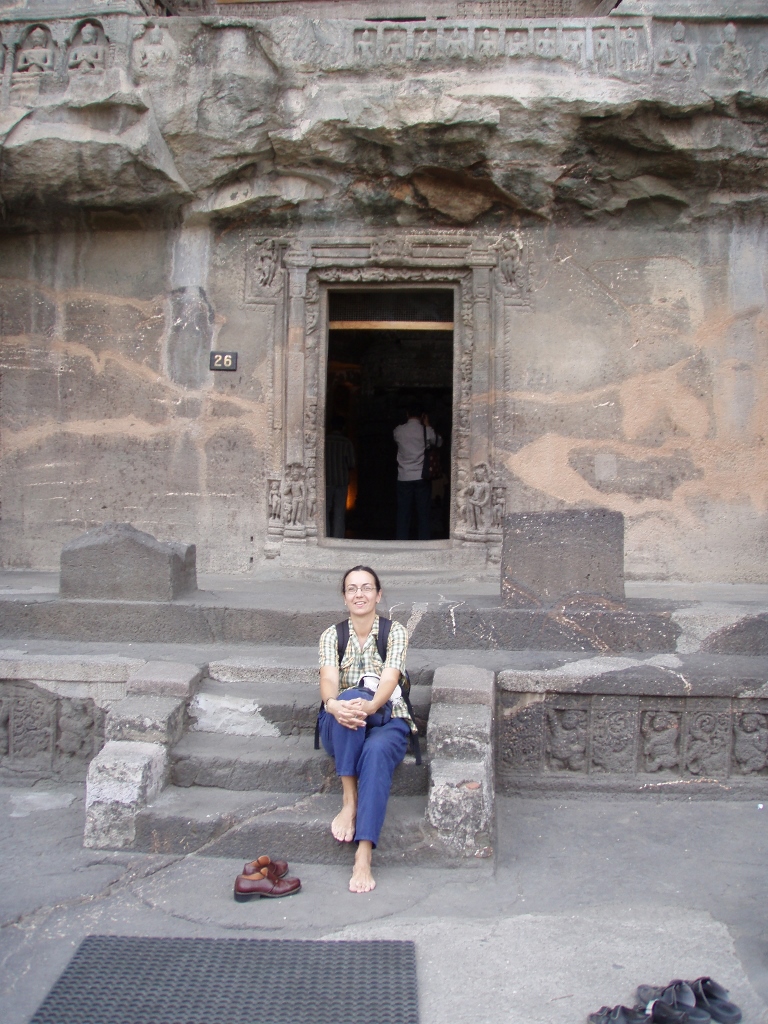 Brief repose after the visit to Cave no. 26
Brief repose after the visit to Cave no. 26
So, it was here that the two of us more or less finished with our sightseeing of Ajanta Caves. It also needs to be said that the caves were made at the orders of kings, ministers, distinguished individuals, as well as monks. As far as it may be concluded on the basis of the texts that have survived to date, the caves were used as the places to which monks retreated during the monsoons and they were also the places where travelling merchants and pilgrims in ancient India could rest.
No matter what one reads about these caves, until they have been seen live and until they have been personally entered, there is no way that their concept can truly be understood and appreciated. It is impossible to describe and realistically convey the enormous array of the details that exist in these caves, either in the form of wall paintings or bas-reliefs, but almost each one of these details makes even a complete layman as myself breathless. No wonder that these caves have been in the UNESCO’s World Heritage List since 1983.
I would certainly love to go there again, but with less stress and more time, since the time was inexorably running for Sneža and I and we still had a three-hour drive to get to Ellora Caves. With a lot of concern as to whether we would make it, we eventually did manage to get to Ellora Caves before they were closed for the day.
Practically, Ellora Caves, which are also in the UNESCO’s World Heritage List, follow almost the same concept as Ajanta Caves, but this does mean “you’ve seen Ajanta, so you don’t have to see Ellora.” Absolutely not and quite to the contrary. It is very important to see both sites.
Because, apart from the fact that each cave at both sites is impressive in its own way, certain differences do exist. To start with, here there are 34 caves made approximately in the period from the 7th century to the 10th century, i.e., they were made after those in Ajanta. In addition, here there is the presence of three religions, so that the caves are divided into three groups: the Buddhist caves (no. 1 to 12) made in the period from 600 to 800 CE, the Hindu caves (no. 13 to 29) made in the period from 600 to 900 CE and the Jain caves (no. 30 to 34) made in the period from 800 to 1000 CE.
Also important for this story is the fact that Sneža and I came rather late and we had very limited time before the closing of the site which happens at the time when the Sun sets.
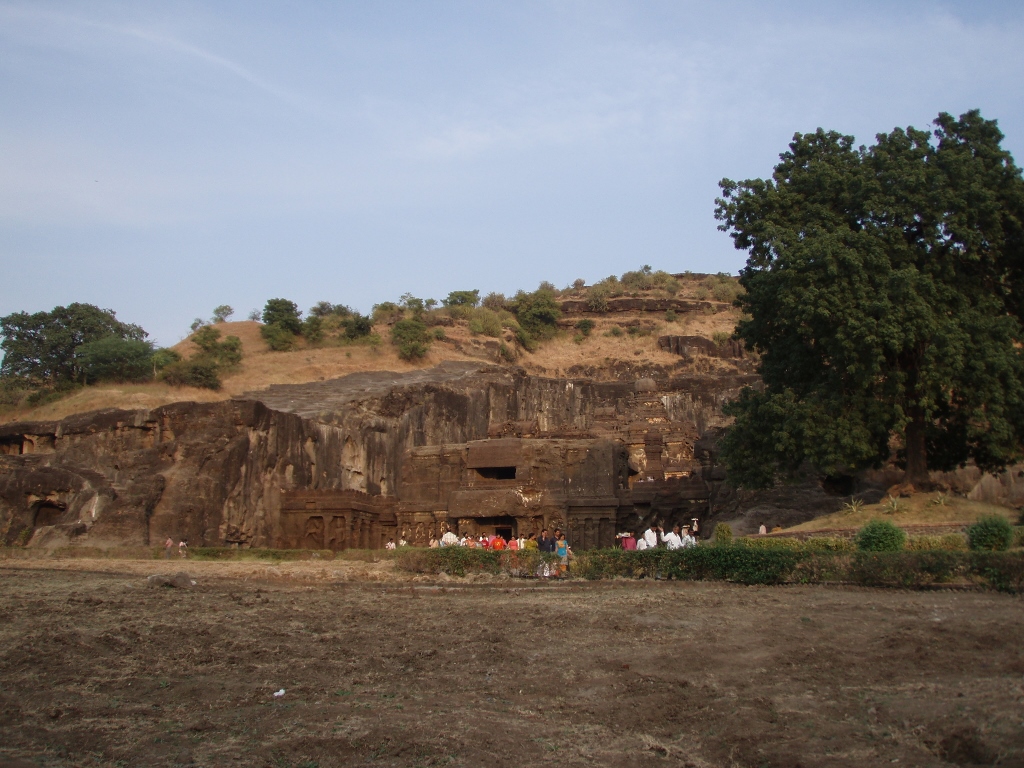 Arriving at Ellora Caves
Arriving at Ellora Caves
As you enter the site, you formally first come across “cave” no. 16, which is in fact the most impressive temple in Ellora. This is Kailasa or Kailasanatha Temple. Everything, absolutely everything in connection with this temple is utterly incredible and the only possible reaction is the dropping of the jaw.
Namely, as opposed to Ajanta Caves where the carving was done frontally, into the depth of the vertical rocks, in the case of Kailasa Temple, the creators had a larger mass of rock which also had its vertical wall, as well as a mildly sloping top in the form of a flat surface that extends into the depth. The creation of the temple started precisely like that, from the very top, and then the carving went from the top down.
The result is a complex structure of the temple itself together with the surrounding decorations in the form of a couple of free-standing pillars, as well as sculptures of elephants, all of that within a spacious courtyard surrounded with numerous pillars and rooms in the shape of large niches/verandas, occasionally on a couple of floors. The size of the rectangular courtyard that extends into the depth is 82 m x 46 m, while the back end is around 33 m high. In this endeavour, around 200,000 tons of rock were carved and discarded (there are estimates that go up to 400,000 tons). Of course, the creators did not make only some rough structures, but rather everything is decorated to an incredible level of details. The overall impression is spectacular.
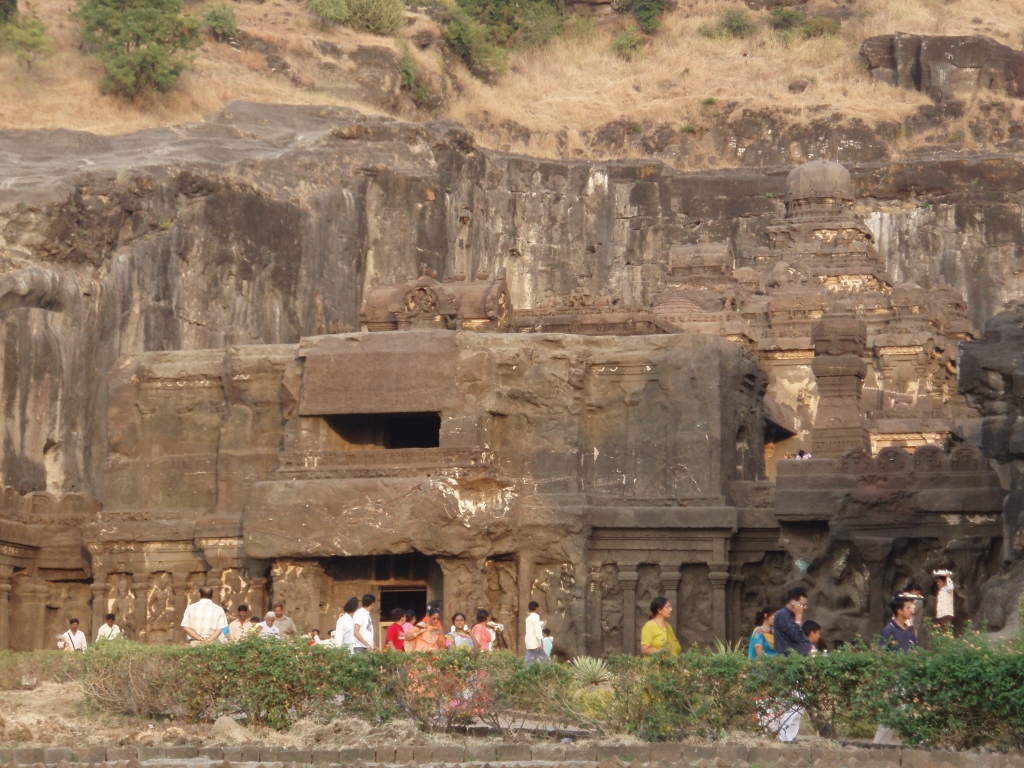 Getting close to the gate through which one enters Kailasa Temple; the top of the vimana (temple’s tower) may be discerned in the back
Getting close to the gate through which one enters Kailasa Temple; the top of the vimana (temple’s tower) may be discerned in the back
For the sake of comparison, it is often mentioned that the temple takes up an area that is twice as large as the one covered by Parthenon in Athens, Greece, as well as that this temple is higher than Parthenon. Also, taking into account that it was not “built,” but rather carved out of rock, Kailasa Temple is at the same time the biggest monolith sculpture in the world.
The making of this temple was ordered by King Krishna I (ruled in the period 756-773) who belonged to the Rashtrakuta dynasty. It is a dynasty that ruled between the early Chalukya dynasty and the Western Chalukya Empire, and it was precisely the father of King Krishna I who defeated the Chalukyas. As the future king participated in the military campaign of his father, he had an opportunity to see Virupaksha Temple in Pattadakal (see: https://www.svudapodji.com/en/india-10/) and he was so impressed with it that he decided and ordered Kailasa Temple in Ellora to be made in such a way that it was three times bigger than the paragon in Pattadakal. Taking into consideration the size of the temple, the manner in which it was made and the times when the temple was made, it sounds almost unbelievable when one comes across the data saying that it was finished within a period of 17-18 years.
As you pass the entrance gate and walk into the temple’s courtyard, and as new details and sights are revealed, it is absolutely incredible and magnificent what the ancient masters did here in the rock. Already at the very entrance, the visitor faces the size of the parts of the temple.
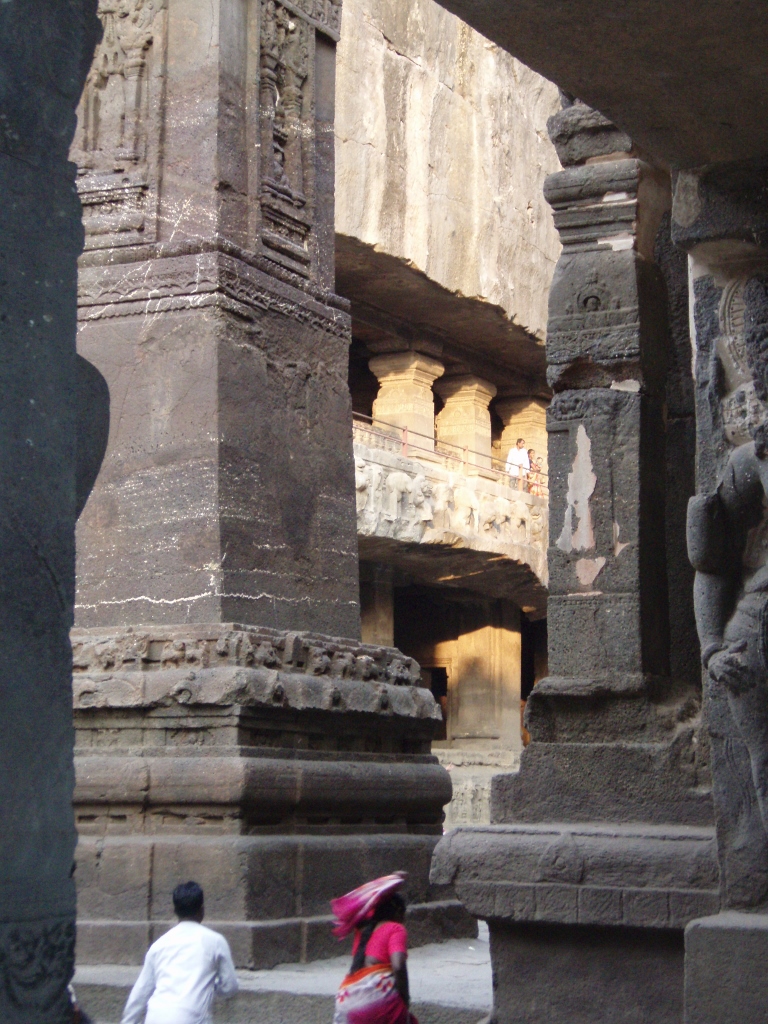 To the left is the lower section of the two free-standing pillars and lit by the Sun there are also the spaces on the upper floor in the rock carried by large pillars
To the left is the lower section of the two free-standing pillars and lit by the Sun there are also the spaces on the upper floor in the rock carried by large pillars
Upon entering the complex, one comes directly across the composition Lakshmi with Elephants. Goddess Lakshmi is the wife of god Vishnu and she is also the goddess of fortune, wealth and prosperity. Here she is sitting on a lotus that is at the same time her symbol and she is bathing thanks to two elephants who are pouring water on her from the vessels they are holding above her head.
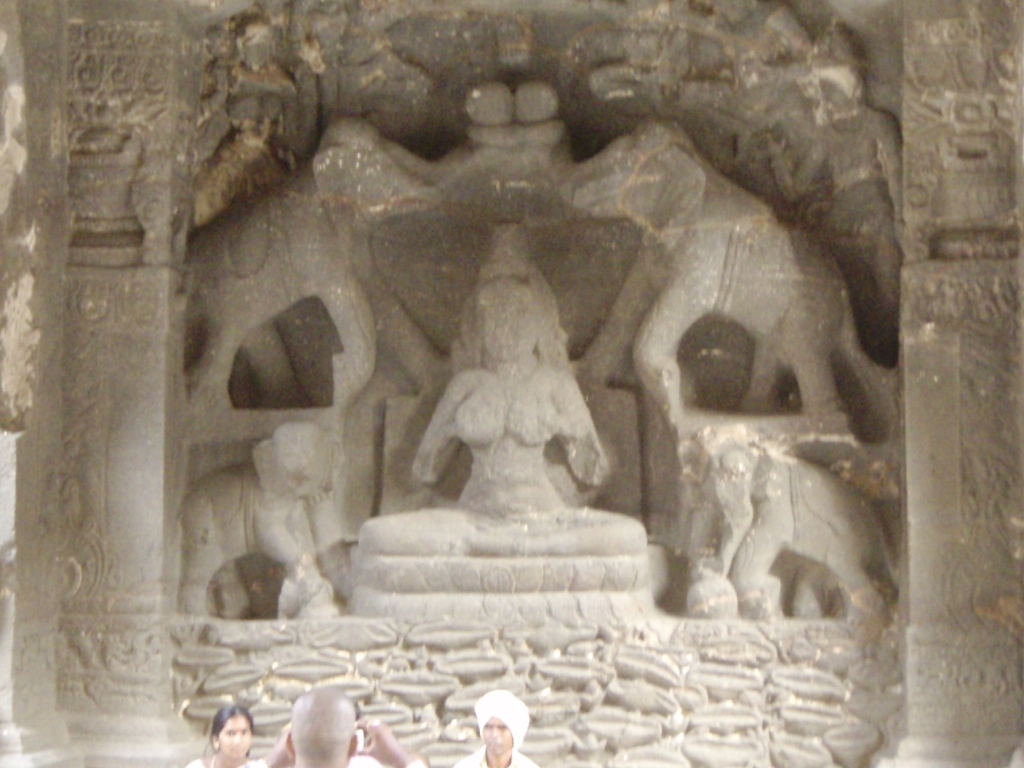 Lakshmi with Elephants
Lakshmi with Elephants
By the way, the temple belongs to the group of the Hindu temples in Ellora and is dedicated to god Shiva. Apart from the lingam in the central sanctum, this may also be concluded by the very name of the temple since Kailasa is the mountain on which Shiva has his abode. In fact, Mount Kailash is a 6638 m high peak in the Himalayas and it is located in China.
So, when you pass the gate and enter the courtyard, it can be seen that the courtyard was made at two levels. The first and the smaller one is precisely that part which is entered first and then come several steps that lead to the second level on which the temple is positioned. In this way, the temple gets an even more impressive spot. By the way, let me say that I don’t have any photo that shows the entire temple, since I could not get it all by my camera on account of its size, as well as the massive gate and the walls in the foreground. The whole temple can probably be seen best from the height, i.e., from an elevation in the back of the temple and we could see some people walking there, looking at the temple, but of course the two of us simply did not have the time for something like that.
At the first level, in the access courtyard, on both sides there are sculptures of elephants in their natural size. They are damaged, the trunks are missing, but this does not diminish in any way the general favourable impression.
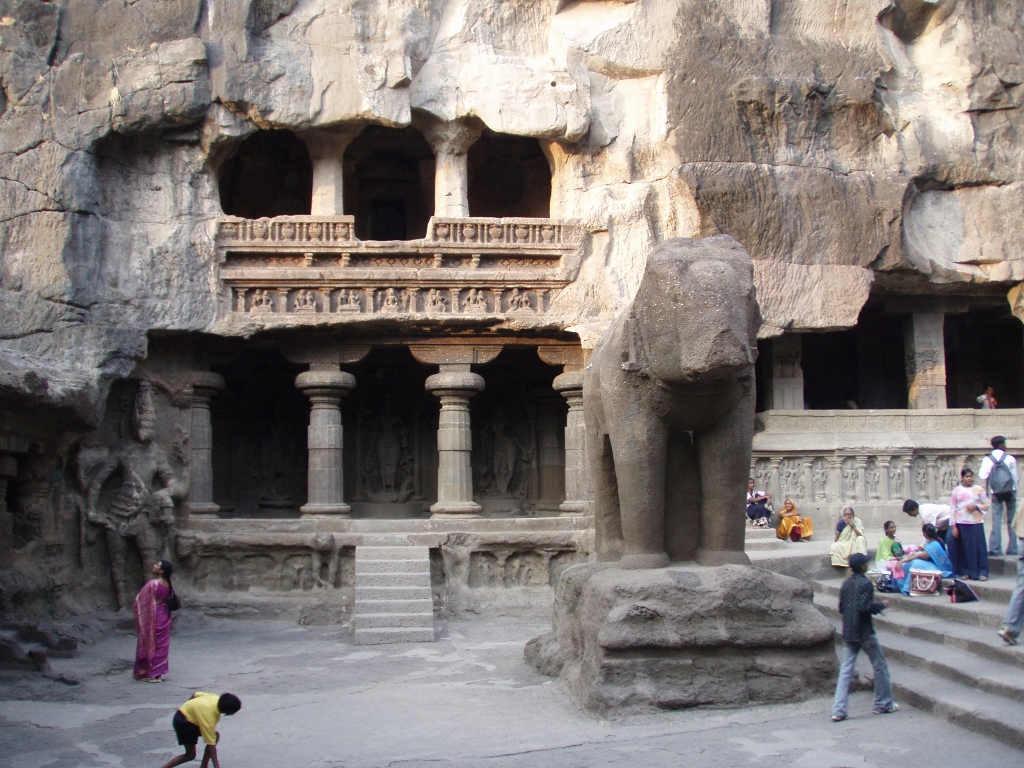 Access courtyard to the left from the entrance
Access courtyard to the left from the entrance
Sneža and I decided to make a circle around the temple first in order to see it from the outside.
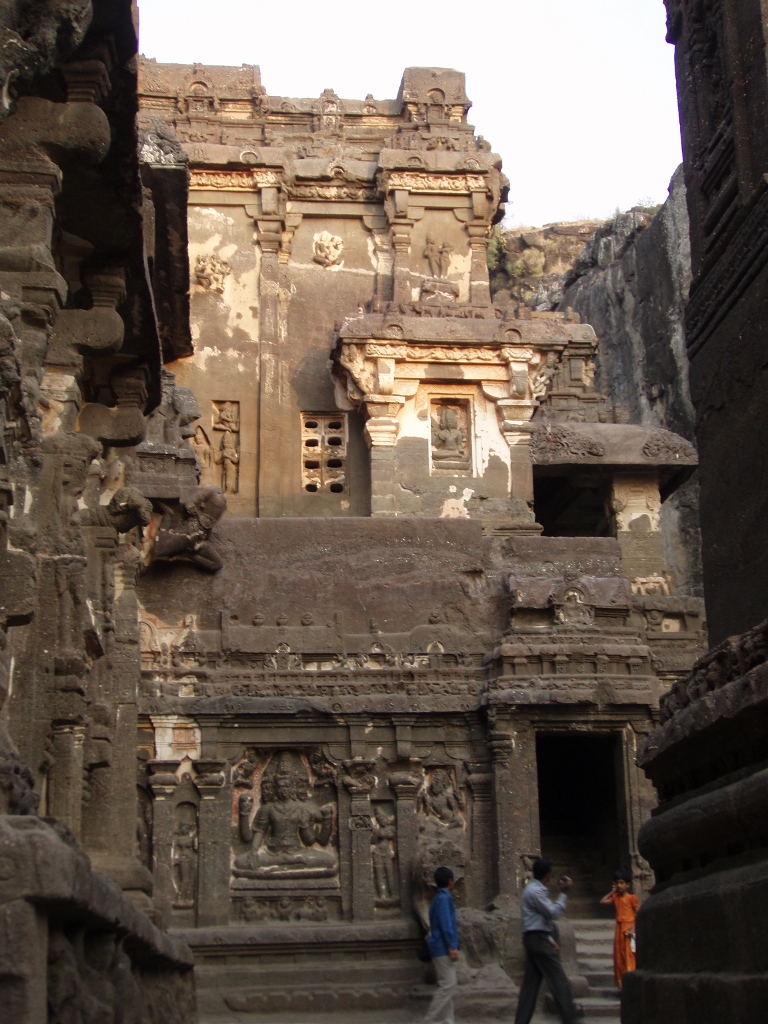 The right-hand side of the temple seen between the central part and the right-hand side pillar
The right-hand side of the temple seen between the central part and the right-hand side pillar
That main part of the temple consists of a mandapa (a hall filled with pillars) through which one approaches the central sanctum called garbhagriha in which there is a lingam as the symbol of god Shiva. Practically in front of the mandapa, i.e., opposite the garbhagriha, there is a pavilion in which there is a sculpture of Nandi, the sacred bull that is the guardian of the gates at the home of Shiva on mountain Kailasa. Here, this pavilion called Nandi Mandapa, as well as the central mandapa and the garbhagriha are located on the second floor (they are around 7 metres high) and they are linked by a stone bridge. The bas-relief of Lakshmi with Elephants decorates one side of the ground-floor part of Nandi Mandapa and that ground-floor part of the pavilion is fully filled, i.e., it was not carved, but rather the solid rock was left as it was.
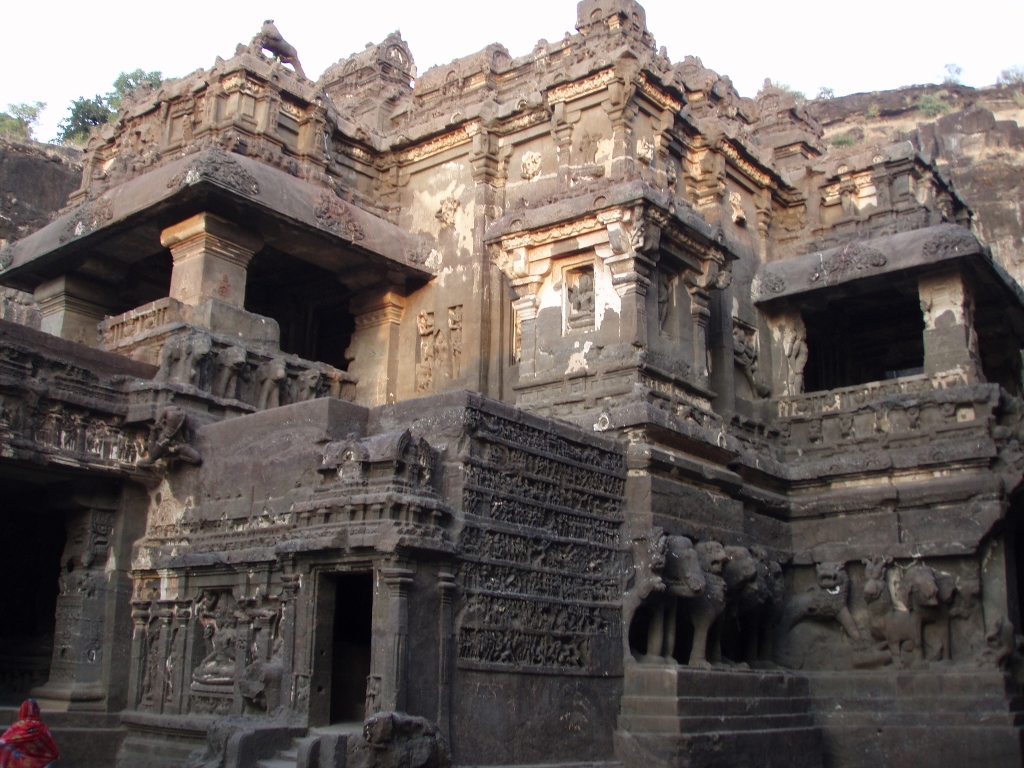 View upwards at the central and the right-hand side parts of the temple in which there is the central mandapa, including the verandas
View upwards at the central and the right-hand side parts of the temple in which there is the central mandapa, including the verandas
When you look a little better at the details of the temple, you can see that there are not only opulent plastic decorations, but also the remains of painted sections.
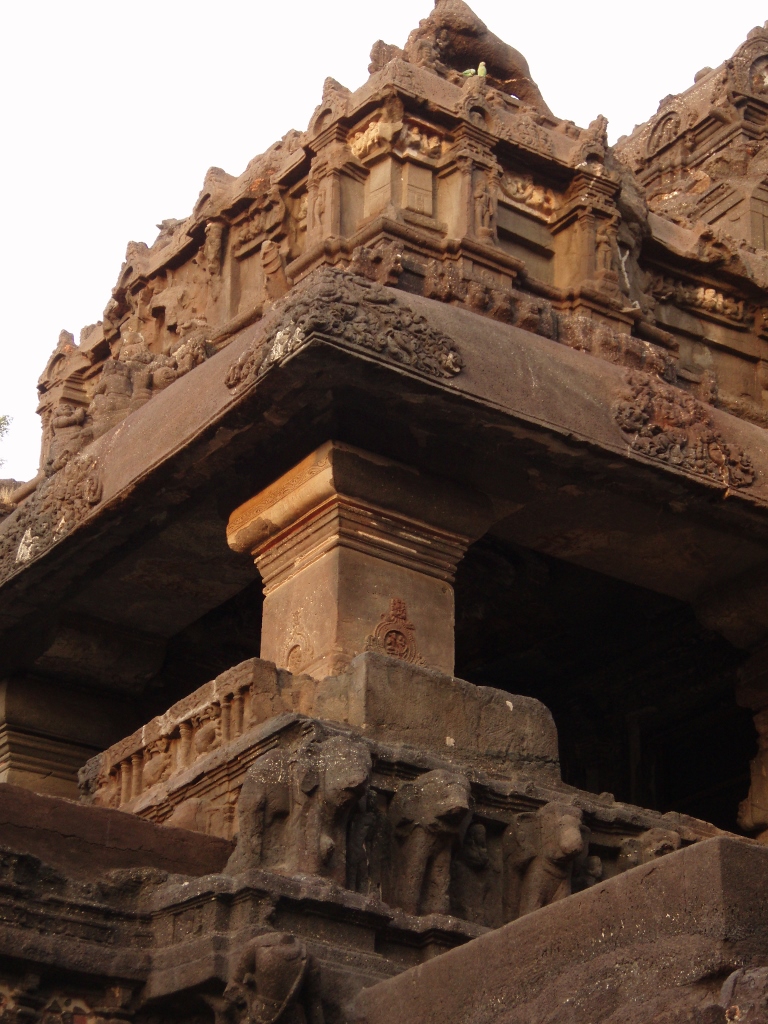 Details from the front veranda in front of the mandapa
Details from the front veranda in front of the mandapa
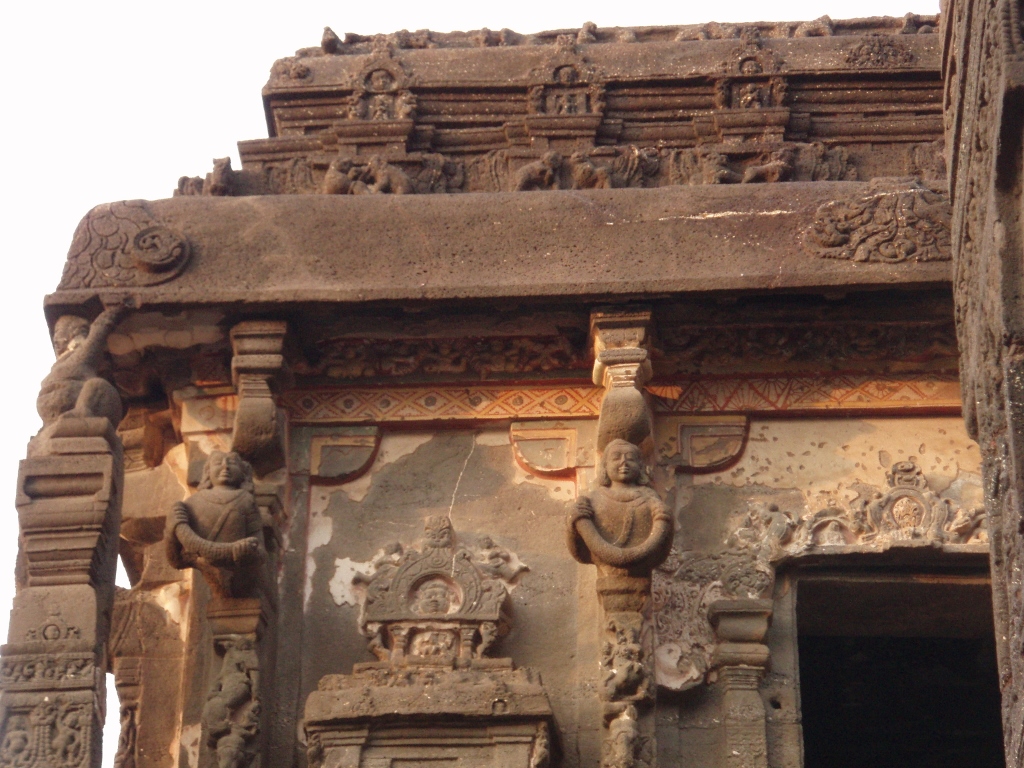 Details from Nandi Mandapa
Details from Nandi Mandapa
In addition to the sculptures and the plastic decorations that are repeated and that serve an ornamental function to a certain degree, there are also those that have a clear symbolic function, as well as entire compositions that depict certain stories linked to the life of the gods. Thus, the photo below, as well as different other photos from the visit to Kailasa Temple, show a frieze made of bas-relief elephants made at the ground floor of the temple and those elephants symbolically carry the whole temple and the mountain on their backs.
Also, in the recess that can be seen in the photo below, it is possible to discern partially Ravana, a demonic king from Ramayana, who is shaking mountain Kailasa in order to disturb Shiva and Parvati in their home.
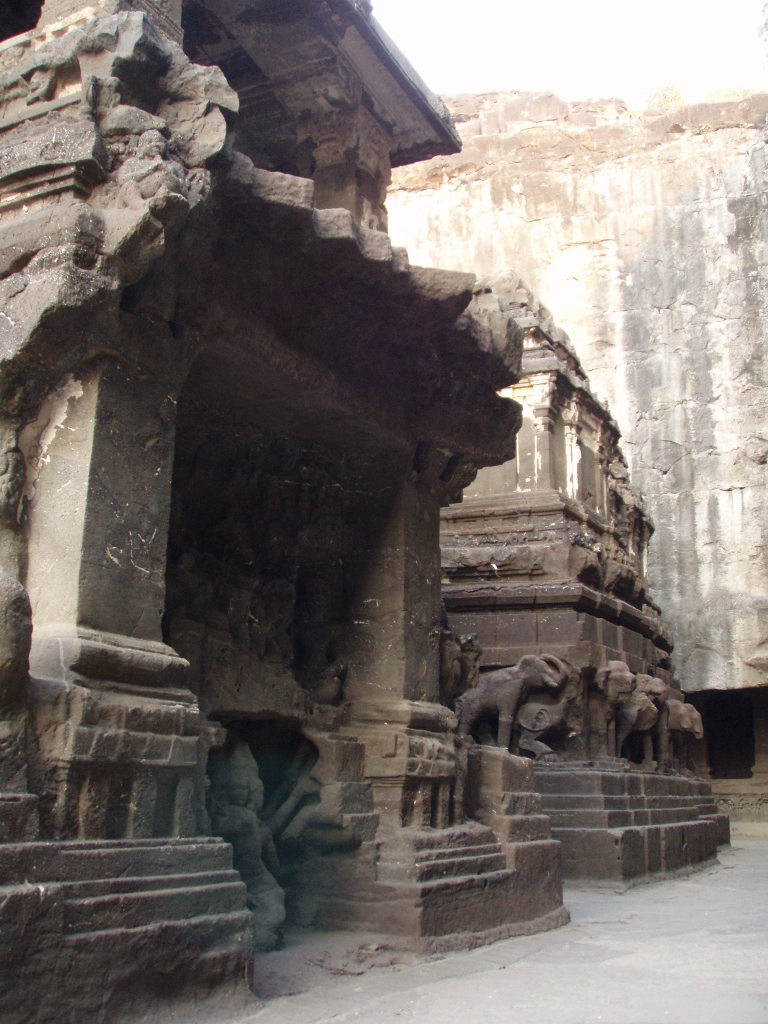 Right-hand lateral part of Kailasa Temple
Right-hand lateral part of Kailasa Temple
While we were walking around the temple, we decided to visit also a particularly interesting side niche called the Hall of Sacrifice.